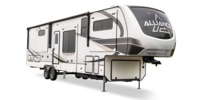What Does RV Stand For and What is It? Your Complete RV Guide to 2021 RVs are seeing a surge in popularity, which begs the question, what does RV stand for? The meaning and history behind RVs might surprise you. And, little did you know, that the American RV has roots back to the American Western expansion. Learn what RV stands for, and where RVs come from. Find out what types of RVs are available, as well as what differentiates them from one another. And, see the surprising history behind the RV and discover why it is as American as apple pie.
What Does RV Stand For and What Are They?
If you want to know “what does RV stand for?” – RV stands for Recreational Vehicle (RV), which comes in the form of, either, a motorhome or a trailer. A trailer RV is towed behind a vehicle, whereas a motorhome RV is an all-in-one self-motorized vehicle. Motorhome RVs can be Class-A, Class-B, or Class-C, while trailer RVs can either be a truck camper, pop-up, caravan, toy-hauler, or fifth-wheel trailer. The distinguishing characteristic of an RV is that of living accommodations, which usually include a bathroom, kitchen, sleeping quarters, and lounge space. Trailers and motorhomes can range in size and quality, from small utilitarian campers to large and luxurious fifth-wheelers. The majority of RVs are single-decker, and – depending on the type of RV – can sleep between 2 to 8 people comfortably.
Where Do RVs Come From? The History of RVs (1745 – 2021)
The RV is as old as the American frontier, and the covered wagons carrying settlers across the breadth of the newly acquired Country. In these early days, covered wagons served all the same essential functions as would come to be indicative of the RV. It served as settlers' sleeping quarters, living space, kitchen – and a few oxen made it an all-in-one self-motorized form of transportation. By the 1920s, the RV evolved into a truly self-motorized form of transportation, as adopted from the still-recently established advent of the automobile. These are the early days of motorized recreation, where the American roads are unpaved, the wilderness expansive, and RV clubs became staples across the country. This landscape bears little resemblance to the RV park-riddled countryside that now exists.
RVs and the Great Depression of the 1930s
In the early days of RVing, boondocking was the only type of travel that existed for an RV. In the 1930s the great depression brought stark new importance to the American RV when many families lost their homes and became dependent on the living quarters of their once recreational extravagance. In these hard years, an RV was a lifeline if you were a displaced worker. In the aftermath of World War II, America's manufacturing prowess was second to none in the world, and RV manufacturers found a newly invigorated market eager to “recreate.” The 1950s saw the largest expansion of RV manufacturing to date, and more Americans than ever before took to the paved highways in search of nature's tranquility and adventure.
RV’s in 19th-Century Europe
Covered wagons might be one of the earliest ancestors to the RV, but they did not feature the type of living accommodations that you come to expect from a modern RV. In the early 1800s, France was home to the first RVs that did more than just transport people and goods. Instead, these French wagons were purpose–built for use by gypsies, circus performers, and traveling salesmen. Similar wagons showed up in Britain, around 1820, and Italian Romani people adopted the caravan living style in the 1850s. Canada is arguably the earliest adopter of modern-day RVs, and in 1910 started manufacturing trailer RV. These early motorhomes were designed and built atop a car or truck – very much like a modern-day trailer RV.
RVs Post-WWII: The Modern RV is Born
In 1929, the first motorized RV was created in Australia, which still exists today in the Goolwa Museum. But, it wasn't until the 1950s when American RVs came into their right, thanks to mobile homes. Mobile homes were already established in the United States, and many were under 9-feet long, which ends up being the basic design for early motorhomes, like Airstream trailers.
Mobile homes and motorhomes continued to split the industry through the 1950s, and today, the difference is stark. A motorhome has always been a symbol of limitless freedom, and they continue to do so today. By 2021, RVs have evolved into turn-key living solutions that include unrestricted access to the open road, and all America has to offer.
Are you ready to claim your freedom on the open road in 2021? If you are still wondering “what does RV stand for?” or are interested in your own fifth-wheel luxury RVs, talk to an Alliance RV associate today.









